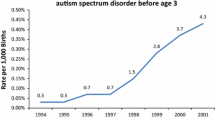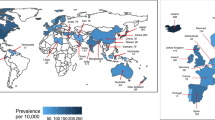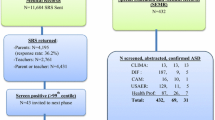Abstract
The prevalence of autism spectrum disorders (ASD) from the 2007 National Survey of Children’s Health (NSCH) was twice the 2003 NSCH estimate for autism. From each NSCH, we selected children born in the US from 1990 to 2000. We estimated autism prevalence within each 1-year birth cohort to hold genetic and non-genetic prenatal factors constant. Prevalence differences across surveys thus reflect survey measurement changes and/or external identification effects. In 2003, parents were asked whether their child was ever diagnosed with autism. In 2007, parents were asked whether their child was ever diagnosed with an ASD and whether s/he currently had an ASD. For the 1997–2000 birth cohorts (children aged 3–6 years in 2003 and 7–10 years in 2007), relative increases between 2003 autism estimates and 2007 ASD estimates were 200–600 %. For the 1990–1996 birth cohorts (children aged 7–13 years in 2003) increases were lower; nonetheless, differences between 2003 estimates and 2007 “ever ASD” estimates were >100 % for 6 cohorts and differences between 2003 estimates and 2007 “current ASD” estimates were >80 % for 3 cohorts. The magnitude of most birth cohort-specific differences suggests continuing diagnosis of children in the community played a sizable role in the 2003–2007 ASD prevalence increase. While some increase was expected for 1997–2000 cohorts, because some children have later diagnoses coinciding with school entry, increases were also observed for children ages ≥7 years in 2003. Given past ASD subtype studies, the 2003 “autism” question might have missed a modest amount (≤33 %) of ASDs other than autistic disorder.

Similar content being viewed by others
References
American Psychiatric Association. (2000). Diagnostic and statistical manual of mental disorders (4th ed.), text revision (DSM-IV-TR). Washington, DC: American Psychiatric Publishing.
Lotter, V. (1966). Epidemiology of autistic conditions in young children. Social Psychiatry, 1, 124–137.
Ritvo, E. R., Freeman, B. J., Pingree, C., et al. (1989). The UCLA-University of Utah epidemiologic survey of autism: Prevalence. American Journal of Psychiatry, 146, 194–199.
Chakrabarti, S., & Fombonne, E. (2001). Pervasive developmental disorders in preschool children. JAMA, 285, 3141–3142.
Croen, L. A., Grether, J. K., Hoogstrate, J., & Selvin, S. (2002). The changing prevalence of autism in California. Journal of Autism and Developmental Disorders, 32, 207–215.
Gurney, J. G., Fritz, M. S., Ness, K. K., Sievers, P., Newschafffer, C. J., & Shapiro, E. G. (2003). Analysis of prevalence trends of autism spectrum disorder in Minnesota. Archives of Pediatrics and Adolescent Medicine, 157, 622–627.
Yeargin-Allsopp, M., Rice, C., Karapurkar, T., Doernberg, N., Boyle, C., & Murphy, C. (2003). Prevalence of autism in a US metropolitan area. JAMA, 289, 49–55.
Newschaffer, C. J., Falb, M. D., & Gurney, J. G. (2005). National autism prevalence trends from United States special education data. Pediatrics, 115, e277–e282.
Barbaresi, W. J., Katusic, S. K., Colligan, R. C., Weaver, A. L., & Jacobsen, S. J. (2005). The incidence of autism in Olmstead County, Minnesota, 1976–1997: Results from a population-based study. Archives of Pediatrics and Adolescent Medicine, 159, 37–44.
Shattuck, P. T. (2006). The contribution of diagnostic substitution to the growing administrative prevalence of autism in U.S. special education. Pediatrics, 117, 1028–1037.
Centers for Disease Control and Prevention. (2006). Mental health in the United States: Parental report of diagnosed autism in children aged 4–17 years—United States, 2003–2004. MMWR, 55(17), 481–486.
Fombonne, E., Zakarian, R., Bennett, A., Meng, L., & McLean-Heywood, D. (2006). Pervasive developmental disorders in Montreal, Quebec, Canada: Prevalence and links with immunizations. Pediatrics, 118, e139–e150.
Centers for Disease Control and Prevention. (2007). Prevalence of autism spectrum disorders—Autism and developmental disabilities monitoring network, six sites, United States, 2000. Surveillance Summaries, February 9, 2007. MMWR, 56(SS-01), 1–11.
Centers for Disease Control and Prevention. (2007). Prevalence of autism spectrum disorders—Autism and developmental disabilities monitoring network, 14 sites, United States, 2002. Surveillance Summaries, February 9, 2007. MMWR, 56(SS-01), 12–28.
Parner, E. T., Schnedel, D. E., & Thorsen, P. (2008). Autism prevalence trends over time in Denmark. Archives of Pediatrics and Adolescent Medicine, 162, 1150–1156.
Hertz-Picciotto, I., & Delwiche, L. (2009). The rise in autism and the role of age at diagnosis. Epidemiology, 20, 84–90.
Fombonne, E. (2006). Past and future perspectives on autism epidemiology. In S. O. Moldin & J. L. R. Rubenstein (Eds.), Understanding autism: From basic neuroscience to treatment (pp. 25–47). Boca Raton, FL: Taylor and Francis Group.
Kogan, M. D., Blumberg, S. J., Schieve, L. A., et al. (2009). The prevalence of parent-reported diagnosis of autism spectrum disorder among children in the United States, 2007. Pediatrics, 124, 1395–1403.
Centers for Disease Control and Prevention. (2009). Prevalence of autism spectrum disorders—Autism and developmental disabilities monitoring network, United States, 2006. Surveillance summaries, December 18, 2009. MMWR, 58(No. SS-10), 1–20.
Arndt, T. L., Stodgell, C. J., & Rodier, P. M. (2005). The teratology of autism. International Journal of Developmental Neuroscience, 23, 189–199.
Landrigan, P. J. (2010). What causes autism? Exploring the environmental contribution. Current Opinion in Pediatrics, 22, 219–225.
Blumberg, S. J., Olson, L., Frankel, M. R., et al. (2005). Design and operation of the National Survey of Children’s Health, 2003. Vital Health Statistics, Series, 43, 1–124.
Blumberg, S. J., Foster, E. B., Frasier, A. M., et al. (2009). Design and operation of the National Survey of Children’s Health, 2007. National Center for Health Statistics. Vital Health Statistics, Series 1: Program and Collection Procedures. May 2009. Available at: ftp://ftp.cdc.gov/pub/health_Statistics/NCHS/slaits/nsch07/2_Methodology_Report/NSCH_Design_and_Operations_052109.pdf.
Shattuck, P. T., Durkin, M., Maenner, M., Newschaffer, C., Mandell, D. S., Wiggins, L., et al. (2009). Timing of identification among children with an autism spectrum disorder: Findings from a population-based surveillance study. Journal of the American Academy of Child and Adolescent Psychiatry, 48, 474–483.
Jarquin, V. G., Wiggins, L. D., Schieve, L. A., & Van Naarden-Braun, K. (2011). Racial disparities in community identification of autism spectrum disorders over time; Metropolitan Atlanta, Georgia, 2000–2006. Journal of Developmental and Behavioral Pediatrics, 32(3), 179–187.
Author information
Authors and Affiliations
Corresponding author
Additional information
The findings and conclusions in this report are those of the authors and do not necessarily represent the official position of the Centers for Disease and Control and Prevention.
Rights and permissions
About this article
Cite this article
Schieve, L.A., Rice, C., Yeargin-Allsopp, M. et al. Parent-Reported Prevalence of Autism Spectrum Disorders in US-Born Children: An Assessment of Changes within Birth Cohorts from the 2003 to the 2007 National Survey of Children’s Health. Matern Child Health J 16 (Suppl 1), 151–157 (2012). https://doi.org/10.1007/s10995-012-1004-0
Published:
Issue Date:
DOI: https://doi.org/10.1007/s10995-012-1004-0




